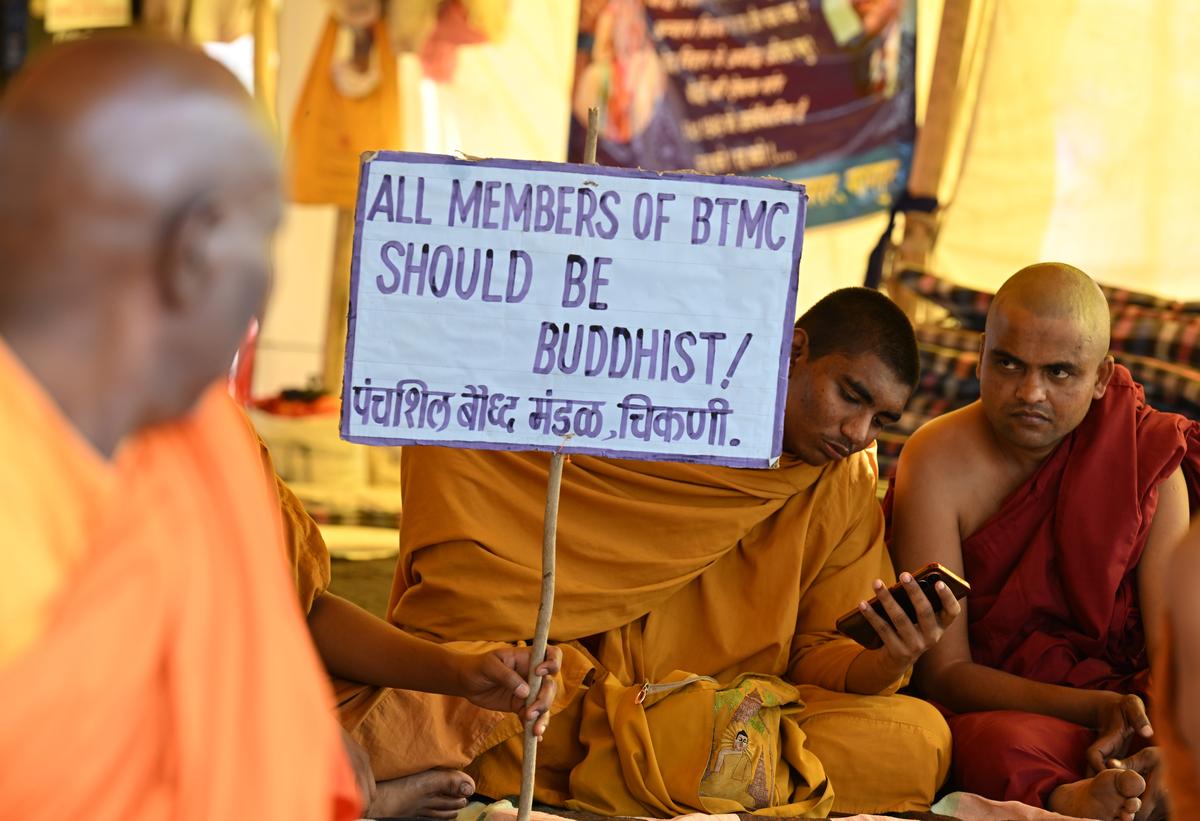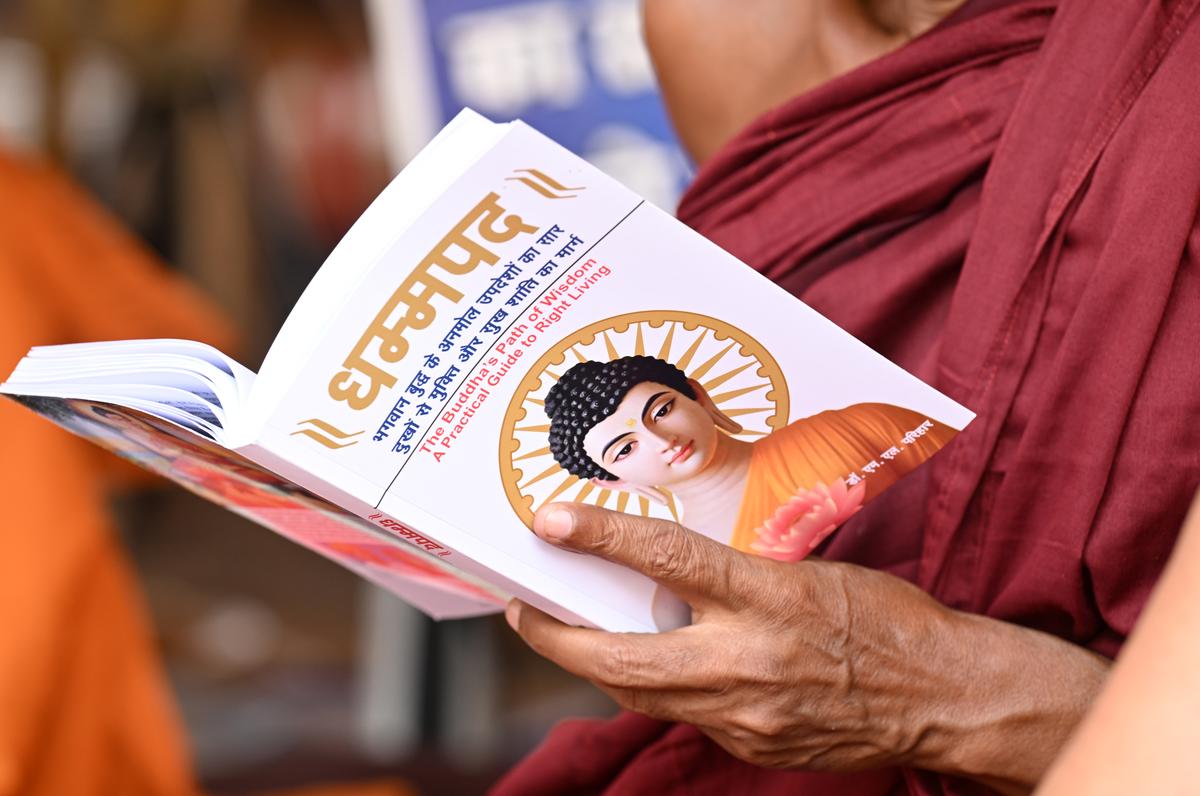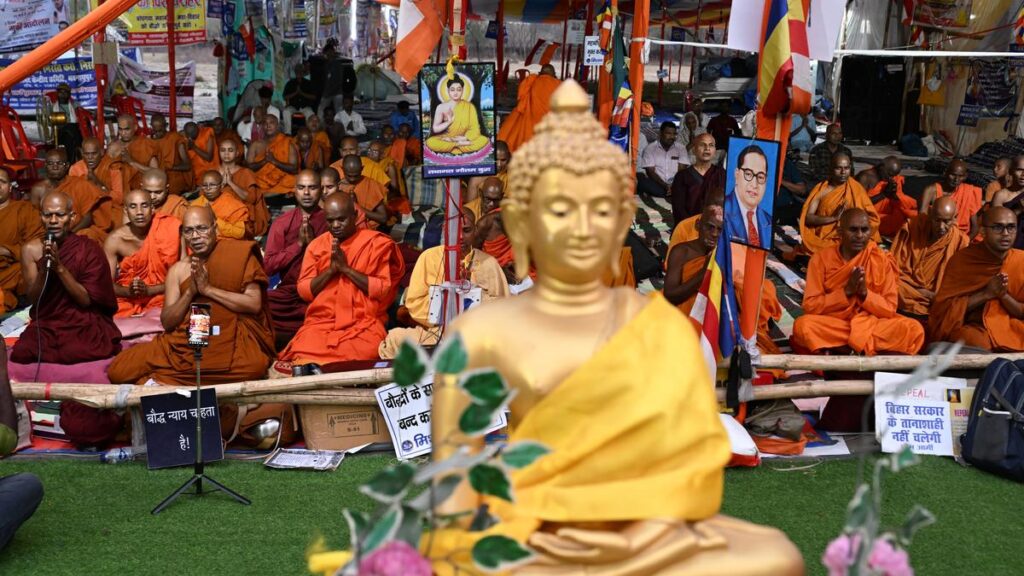There is barely anyone at the site of the peepal tree on the banks of the now-dry Niranjana river, where Siddhartha Gautama became the Buddha, after he is believed to have attained samma-sambodhi(perfect enlightenment). The tree is located at the Mahabodhi temple complex in Bodh Gaya, about 115 km south of Patna, Bihar’s capital. Within the temple too, visitors are sparse. The crowd is a couple of kilometres away, seen from a distance as a colour palette of ochre and maroon. The details emerge close up: of about 300 male monks sitting in protest, interspersed with a few women in white, in front of a gold Buddha statue.
The Buddhist monks, under the banner of the All India Buddhist Forum (AIBF), have been protesting in the temple town since February 12, 2025, demanding the repeal of the Bodh Gaya Temple Act (BT), 1949, which was enacted to regulate the temple’s management and resolve disputes between Hindus and Buddhists.
“We want full control of the temple management committee. Why should there be members from other religions to run our temple management?” says Akash Lama, the monk spearheading the protest. He says the demand is not new, but now, the Buddhist community is determined to continue protesting on the street until their demands are fulfilled.

The monks are demanding the repeal of the Bodh Gaya Temple Act, 1949.
| Photo Credit:
MOORTHY RV
Currently, the temple — a UNESCO World Heritage Centre since 2002, built by emperor Ashoka in the 3rd century B.C. — is administered by the Bodh Gaya Temple Management Committee (BTMC), consisting of four Buddhists and four Hindus, with the District Magistrate of Gaya as ex-officio chairperson.
The protest began near the temple, but the local administration evicted people from there, calling it a “prohibited zone”. On March 1, it moved to Domuhan, by the side of a road, on government land. Here, under a waterproof canopy, they eat and sleep. There is a kitchen to feed the protestors, most from Maharashtra, and bare mattresses that are piled up when not in use.
Jostling for space are colourful Buddhist flags; posters of the Bhim Army, a socio-political organisation founded 10 years ago; and banners of Dr. Bhim Rao Ambedkar, who steered India’s drafting of the Constitution. Dr. Ambedkar, a Dalit, converted to Buddhism to step out of the Hindu caste system. “All those who follow Ambedkarji are Buddhists,” asserts Akash. Those around him nod in agreement.
Temple control
In a letter to the Gaya District Magistrate in March 2025, the AIBF called the current constitution of the BTMC “a complete hoax”, dominated by people “with vested interest”. It said, “The so called four Buddhist members are also handpicked by this vested interest”, tarnishing “the Buddhist image, tradition and culture”.
The four current Buddhists members of the temple management committee have distanced themselves from the protest, saying the key people have “personal ambitions”. There are only two Hindu members listed on the BTMC website.
The Mahabodhi temple, which is regulated by the Bodh Gaya Temple Act, 1949.
| Photo Credit:
MOORTHY RV
In 2012, Buddhist monks had filed a writ petition before the Supreme Court to repeal the 1949 Act. At her plush office in Bodh Gaya, Mahashweta Maharathi, the member secretary of the BTMC, says, “I cannot comment on this protest as it is unconstitutional. The matter is sub-judice.” She says the present committee was formed on July 17, 2023, with a tenure of three years.
The District Magistrate of Gaya Thiyagarajan S.M. says, “The protesting Buddhists should wait for the court’s verdict on the issue. The protest has been politicised as there are flags and supporters of the Bhim Army at the protesting site.” He says the delegation had met Bihar’s government officials, including those from the Home Department, for their demands.
History meets identity
One of the provisions of the BT Act was that the Bihar government would nominate “a Hindu as chairman of the Committee for the period during which the District Magistrate of Gaya is non-Hindu”. In the 1960s, for instance, a Muslim IAS officer, K.M. Zuberi was appointed as Gaya DM. The then government had appointed Jageshwar Prasad, an MLC, as the chairperson of the BTMC for the period of Zuberi’s tenure. An amendment to the law changed this in 2013, making the post of the ex-officio member religion-neutral.
The reason that a Buddhist site has Hindu members on its management committee has a history to it. The Bodh Gaya complex has always seen pilgrims from across the world visit, including Chinese travellers Fa-hien and Hiuen Tsang, who visited the area in the 5thand 7thcenturies A.D., and left accounts of the pilgrimage spots, among other aspects.
In the early 13th century, however, Bakhtiyar Khilji, a Turko-Afghan general of the Ghurid ruler Mohammad of Ghor led the Muslim conquests of the eastern Indian regions of Bengal and Bihar. Buddhism saw a decline, and in 1590, a Hindu monk, Ghamandi Giri, established the Bodh Gaya mutt, a Shaivite monastery. The Shaivites believe that Buddha was the ninth incarnation of the Hindu Lord Vishnu, hence they have a claim over the temple. Hindu priests began to manage the temple thereafter. In the complex of over 11 acres, stands a temple of the Hindu deity Jagannath.
In the 19th century, a Buddhist monk Hevavitarna Dharmapala, called Anagarika, or one who gives up worldly possessions, travelled to India. In 1895, as the honorary general secretary of the Mahabodhi Society in then Ceylon, he took the then Mahanth to court over not allowing him to place an image of Buddha in the temple.
The contentious issue was raised at the Gaya session of the Congress in 1922 and a committee under Dr. Rajendra Prasad was constituted for the resolution of the conflict between Hindus and Buddhists for control over the temple site.
After independence, the Bihar government brought in the BT Act, which stipulated that all Buddhists and Hindus had the right to worship at the temple. “The very Act is illegal, unconstitutional and an assault on the freedom of religion,” Akash says.
In the 1990s, the then government under Chief Minister Lalu Prasad Yadav had drafted the Bodh Gaya Mahavihara Bill to replace the BT Act, allegedly to hand over the management of the temple to the Buddhist community. The Bill had prohibited idol immersion near the temple and Hindu marriages inside, but it was never passed.
In 2015, the AIBF was formed in Siliguri, West Bengal, and since then they, along with several other Buddhist organisations have been demanding the repeal of the BT Act. In November 2023, Buddhist monks had held a rally in Gaya and submitted a memorandum to the Central and State governments to ask for this, but when it did not have the desired result, the monks again held a rally in Patna in 2024. They began the indefinite sit-in protest on February 12, 2025. It has been two months now, and their numbers are growing.

A protester at the site with a book on Buddhism.
| Photo Credit:
MOORTHY RV
“Several legislators and parliamentarians who sympathise with our cause have raised the issue in the State Assembly and the Lok Sabha,” says Bhante Karunashil, who has come from Haryana to join the protest. “Have you heard of any religious site being governed by members of another faith?” he says, angrily.
The Buddhist-Hindu debate reached Parliament in April this year, during the debates on the Waqf (Amendment) Bill, 2025, which sought to include non-Muslims into boards governing Waqf property, and also put District Collectors in-charge of disputes in their areas. Upendra Kushwaha, currently an MP from the Rajya Sabha and formerly elected from Karakat, in Bihar, said that while the Congress was opposing the Waqf Bill now, “they were in power (in Bihar then in 1949) when the BT Act was passed”.
“Back then, you didn’t feel that it is a Buddhist temple and so you thought control should not be with them. On behalf of my party (Rashtriya Lok Morcha), I appeal that we give the temple back to the Buddhists so that they can manage the affairs their way,” he said.
Communist Party of India (Marxist-Leninist) legislator from Makhdumpur constituency of Jehanabad district, who is from the neighbouring Gaya district, raised the issue in Bihar’s Assembly on March 7, 2025. He says he also submitted a letter to Chief Minister Nitish Kumar and Deputy Chief Minister Samrat Choudhary in support of the protesting Buddhists. “But since then, nothing has happened,” he says.
Later, Satyadeo Ram, an MLA from the same party from Darauli constituency of Siwan district, says he too had raised the issue between March 11 and 13 in the State Assembly, but no action has been taken yet.
Money matters
Several members of the Buddhist community say that the real fight is over the vast funds of the temple. In fact in 2000, there had been infighting among Buddhist monks over finances from abroad. Maharathi, however, says all donations are carefully audited because they are governed by the rules of the Foreign Contribution Regulation Act, 2010. On the BTMC website, the link to its annual report is not functional. In 2023, the Centre had slapped a fine of ₹80 lakh for allegedly violating FCRA provisions.
Bhadant Anand Mahathero, the national president of the Buddhagaya Mahabodhi Vihar All India Action Committee, a group advocating for the temple to be run by the Buddhists, who had written the 2023 letter, says, “The protesting Buddhists federations have given different bank accounts on social media for donations. If this agitation is not for funds, then what is this for?”
In 2024, Union Finance Minister Nirmala Sitharaman had announced development plans for the Mahabodhi temple complex on the lines of the Kashi Vishwanath corridor.”
Published – April 13, 2025 08:00 pm IST
Source:https://www.thehindu.com/news/national/bihar/in-the-shadow-of-the-bodhi-tree/article69445887.ece

